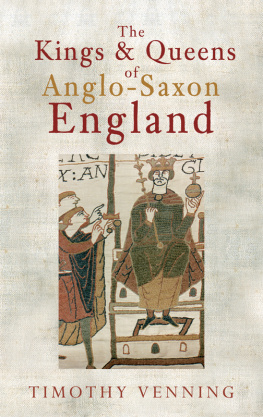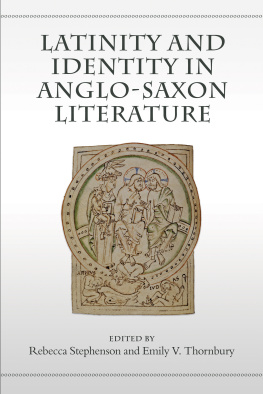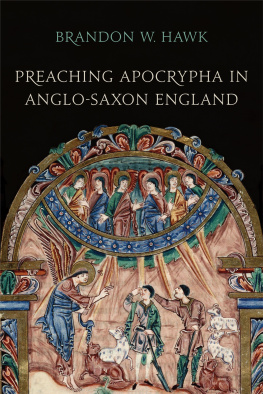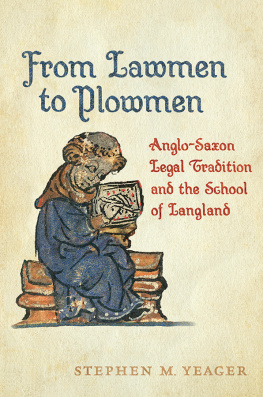THE AESTHETICS OF NOSTALGIA:
HISTORICAL REPRESENTATION IN OLD ENGLISH VERSE
Heroic poetry was central to the construction of Anglo-Saxon values, beliefs, and community identity and its subject matter is often analysed as a window into Anglo-Saxon life. However, these poems are works of art as well as vehicles for ideology. The Aesthetics of Nostalgia reads Anglo-Saxon historical verse in terms of how its aesthetic form interacted with the culture and politics of the period.
Examining the distinctive poetic techniques found in vernacular historic poetry, Rene Trilling argues that the literary construction of heroic poetry promoted specific kinds of historical understanding in early medieval England, distinct from linear and teleological perceptions of the past. The Aesthetics of Nostalgia surveys Anglo-Saxon literary culture from the age of Bede to the decades following the Norman Conquest in order to explore its cultural impact through both its content and its form.
(Toronto Anglo-Saxon Series)
RENE R. TRILLING is an associate professor in the Department of English at the University of Illinois.
The Aesthetics of Nostalgia:
Historical Representation in Old English Verse
RENE R. TRILLING

University of Toronto Press 2009
TorontoBuffaloLondon
www.utppublishing.com
Printed in the U.S.A.
Reprinted in paperback 2016
ISBN 978-0-8020-9971-6 (cloth) ISBN 978-1-4875-2153-0 (paper)
 Printed on acid-free, 100% post-consumer recycled paper.
Printed on acid-free, 100% post-consumer recycled paper.
Library and Archives Canada Cataloguing in Publication
Trilling, Rene R.
The aesthetics of nostalgia : historical representation in Old English
verse / Rene R. Trilling.
(Toronto Anglo-Saxon series)
Includes bibliographical references and index.
ISBN 978-0-8020-9971-6 (bound) ISBN 978-1-4875-2153-0 (paper)
1. English poetry Old English, ca. 4501100 History and criticism. 2. Literature and history England. 3. Nostalgia in literature.4. History in literature.I. Title.II. Series: Toronto Anglo-Saxon series
PR205 T75 2009 829'.1009 C2009-902077-7
The author gratefully acknowledges the University of Exeter Press for permission to quote excerpts from the following: The Ruin, in Three Old English Elegies, ed. R.F. Leslie (Exeter: University of Exeter Press, 1988), pp. 512 (ISBN 978-0-85989-184-4); Deor, in The Exeter Anthology of Old English Poetry, ed. Bernard J. Muir, rev. 2nd ed. (Exeter: University of Exeter Press, 2000), pp. 2813 (ISBN 978-0-85989-629-0); and Widsith, in The Exeter Anthology of Old English Poetry, ed. Bernard J. Muir, rev. 2nd ed. (Exeter: University of Exeter Press, 2000), pp. 23843 (ISBN 978-0-85989-629-0).
University of Toronto Press gratefully acknowledges the financial assistance of the Centre for Medieval Studies, University of Toronto, in the publication of this book.
University of Toronto Press acknowledges the financial assistance to its publishing program of the Canada Council for the Arts and the Ontario Arts Council, an agency of the Government of Ontario.

For Jim and Rowan
Contents
Acknowledgments
It is a tremendous pleasure to be able, finally, to thank the many people whose support, both intellectual and personal, has sustained the creation of this book. Like most academic work, it is largely the fruit of conferences, seminars, workshops, reading groups, colloquia, and informal conversations too numerous to mention. Many people whose offhand remarks made me think differently go unnamed here, as do the scholars before me whose work enabled me to undertake this project in the first place, but I want to acknowledge their contributions.
My first and greatest debt is to my former dissertation director, Katherine OBrien OKeeffe, whose guidance has helped me to develop as a scholar and to avoid many professional pitfalls. Her intellectual rigour and generosity set a very high standard indeed, and it has been an honour to have her as a teacher and mentor. I am also grateful to the members of my dissertation committee at the University of Notre Dame, Gerald Bruns, Jill Mann, and Michael Lapidge, for their criticism as well as their encouragement. I learned a great deal from them and from other members of the Notre Dame faculty, especially Kathleen Biddick, Dolores Warwick Frese, Maura Nolan, and Ewa Plonowska Ziarek. They were kind yet exacting teachers, and I was extremely fortunate to begin my research career under such tutelage. My graduate colleagues also made Notre Dame an inspiring place to think and learn, and I am thankful for the camaraderie of Siobhain Bly Calkin, Sara Crosby, Anne Enenbach, Erich Hertz, Paul Patterson, Scott Smith, and Kathleen Tonry.
The University of Illinois has been a wonderful place in which to bring this project to completion, and I am grateful for this truly remarkable intellectual community. Charlie Wright has been guide, editor, coach, and cheerleader over the past few years, and I feel very lucky to have landed in his department. Dennis Baron, Jon Ebel, Jed Esty, Lori Garner, Stephen Jaeger, Jim Hurt, Marcus Keller, Curtis Perry, Nora Stoppino, Carol Symes, Joe Valente, Julia Walker, and Brian Walsh all read and commented on portions of the project at various stages in its development, and many conversations with Karen Fresco, Andrea Goulet, Catharine Gray, Matt Hart, Anne D. Hedeman, Lilya Kaganovsky, Marianne Kalinke, Zachary Lesser, William Maxwell, Erin Murphy, Michael Rothberg, Rob Rushing, Yasemin Yildiz, and the graduate students in my Fall 2006 seminar helped me to think through new approaches to the material. My department head, Martin Camargo, was a voice of support and reassurance at every stage of this process, and the University has provided generous support in the form of research and travel grants.
My debts extend far beyond Notre Dame and Illinois, however, and it has been my privilege to be a part of a warm and welcoming community of medieval scholars. I am especially grateful to Chris Abram, Tom Bredehoft, Warren Brown, Scott Bruce, Sam Collins, Tracey-Anne Cooper, Abe Delnore, Nick Doane, Martin Foys, Jason Glenn, Bruce Holsinger, Ethan Knapp, Anna Trumbore Jones, Anne Lester, Roy Liuzza, Laura Morreale, Andrew Rabin, Theo Riches, Alice Sheppard, Kathleen Stewart, Paul Szarmach, and Emily Thornbury for serving as interlocutors on many occasions and for reminding me how extraordinary this profession can be. I owe more than I can express to Rebecca Stephenson and Jacqueline Stodnick, who read every word of this book, including many that, thanks to them, are no longer in it. Their humour, honesty, and friendship have been among the greatest rewards of a career in academia.
From the first draft, I dreamed of this book as a Toronto book, and seeing it published by the University of Toronto Press is gratifying indeed. I am very grateful to the editors, Suzanne Rancourt and Barb Porter, who have shepherded me expertly through the publication process, and to the UTP production staff, particularly Theresa Griffin, who have saved me from many errors. I would also like to thank the anonymous readers, whose insightful comments, thoughtful criticism, and enthusiastic evaluations have made the final product a much better book than the one I originally sent them. Their professionalism has been a model for me, and their efficiency has allowed the book to see the light of day sooner than I expected.
Next page








 Printed on acid-free, 100% post-consumer recycled paper.
Printed on acid-free, 100% post-consumer recycled paper.